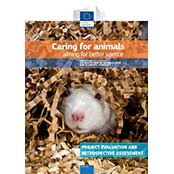Project Evaluation and Retrospective Assessment
2
The table of contents
Introduction………………………………………………………………………………………………………………..4
The related articles of Directive 2010/63/EU ………………………………………………………………….5
Information requirements……………………………………………………………………………………………..6
Examples of problems encountered with project applications………………………………………..7
Project application ………………………………………………………………………………………………………8
Use of templates for project application……………………………………………………………………..8
The level of detail in project applications……………………………………………………………………9
Use of declarations…………………………………………………………………………………………………10
Formulating specific questions………………………………………………………………………………..10
Project evaluation process (who/how)………………………………………………………………………….12
Principles for an effective project evaluation process…………………………………………………12
Models used in project evaluation process………………………………………………………………..12
How can these principles be addressed in practice? …………………………………………………..13
Consideration of different methodologies………………………………………………………………….16
Additional comments on project evaluation process……………………………………………………18
Evaluation of the scientific justification for exemptions and application of the Three Rs……18
Evaluation of the scientific justification for exemptions………………………………………………18
Evaluation of the application of the Three Rs…………………………………………………………….19
Performing a harm-benefit analysis……………………………………………………………………………..20
Factors to take into consideration in assessing benefits………………………………………………21
Factors to take into consideration in assessing harms………………………………………………..23
Factors to take into consideration in assessing likelihood of success……………………………24
Evaluation of the project application………………………………………………………………………..24
How to weigh harms and benefits…………………………………………………………………………….25
How to perform a harm-benefit analysis……………………………………………………………………26
Retrospective assessment……………………………………………………………………………………………28
The benefits of carrying out retrospective assessment…………………………………………………28
Factors to determine whether or not a retrospective assessment should be carried out…..28
The most appropriate time to carry out a retrospective assessment………………………………29
Securing the necessary information for a retrospective assessment………………………………29
3
Guidance on information requirements …………………………………………………………………….30
Outcomes to derive from a retrospective assessment…………………………………………………..31
General recommendations ………………………………………………………………………………………….32
Bibliography ……………………………………………………………………………………………………………33
Appendix I: Pre-formulated questions for building a project application template ……………34
Requirements of Annex VI……………………………………………………………………………………….34
Use of live animals for the purposes of education and training ……………………………………38
Request for an exemption ………………………………………………………………………………………..39
Appendix II: Modified Bateson Cube …………………………………………………………………………40
Appendix III: Further guidance on issues to consider in retrospective assessment ……………41
